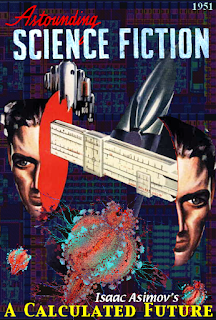 |
| The End, again. |
At the end of Asimov's novel, The End of Eternity, Noÿs believes that she has put an end to time travel. However, she is not aware that both the "Queen of Time Travel", R. Gohrlay, and the Huaoshy, still retain the ability to travel through time. The Time Travel War is still raging!
However, the true end of time travel is near: it comes not in the 1930s but in the 1970s. The end of time travel occurs when the Huaoshy change the dimensional structure of the universe, making time travel physically impossible. It is not particularly hard for the Huaoshy to do this, since it was they who previously altered the universe so as to make possible faster-than-light travel, an act of dimensional engineering that (unbeknownst to the Huaoshy) also made time travel possible.
 |
| Overseer Sachiz |
The Last Replicoid
Are there other consequences arising from the dimensional engineering that ends time travel? Yes. Some of the technologies that were developed by R. Gohrlay make use of sedrons and the physical properties of sedrons were altered by the Huaoshy's final act of dimensional engineering. In particular, R. Gohrlay's system for creating replicoids was inactivated.
Just before the end of time travel, Grean created the last replicoid: a copy of Isaac Asimov. Grean immediately began to call "him" Azynov. Before Azynov was sent off to Tar'tron, he got to meet the future tryp'At Overseer, Sachiz, and the Editor.
 |
| The Adventures of Azynov. |
This "meeting" between the Editor and Azynov provides an opportunity for Grean to prepare Azynov for his "mission" to Tar'tron and to inform the Editor about that mission. After the meeting, Grean puts restraints on the ability of both Azynov and the Editor to remember what they were told by Grean during the meeting. Only later will they be allowed to remember Grean's words.
 |
| In the Buld Reality. Original cover art by Jack Gaughan Special thanks to Miranda Hedman for "Black Cat 9 - stock" that I used to create the green "sedronite" who is in the image, above. |
Immediately after meeting with Grean and the Editor, Azynov becomes a time traveler. Grean makes use of Azynov to make a small adjustment to Reality, making sure that Jack Vance will live to a ripe old age. This allows Grean to demonstrate to Azynov that time travel is possible. However, Azynov is told that soon, time travel will become impossible.
 |
| Original art by Alexey Kashpersky and Hubert Rogers |
Finally, Azynov is taken away from Earth by Many Sails. Azynov is taken to the planet Tar'tron where he begins to learn about Genesaunt Society and the fragments of Humanity that are scattered around the galaxy.
Azynov and his first experiences in the Hierion Domain might be the perfect beginning for the Exode Saga.
Next: Return to Eternity
 |
| visit the Gallery of Book and Magazine Covers |

No comments:
Post a Comment